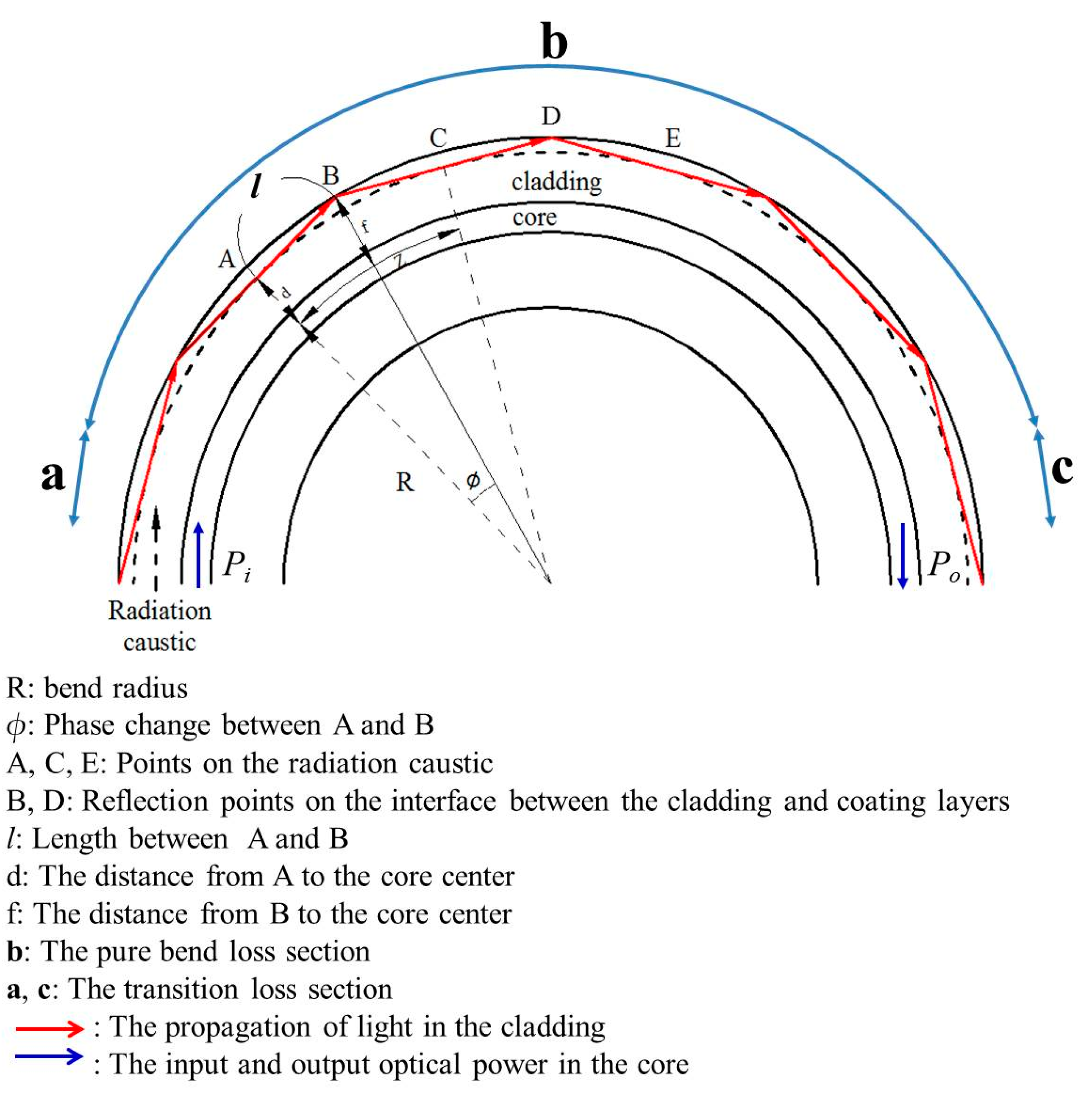A FBG Intensity Modulation System Combined with an Optical Whispering Gallery Mode Edge Filter
Abstract
:1. Introduction
2. The Operating Principles of the Whispering Gallery Mode (WGM) Edge Filter
2.1. The Bend Loss for Single-Mode Optical Fibers
2.2. Phase Difference Formula
3. Experimental Section
3.1. Experimental Setup for Resonant Wavelength Measurement of the Whispering Gallery Mode (WGM) Edge Filter
3.2. Experimental Setup for Static and Dynamic Mode Measurement of the Fiber Bragg Grating (FBG) Intensity Modulation System Based on the WGM Edge Filter
4. Results and Discussion
5. Conclusions
Acknowledgments
Author Contributions
Conflicts of Interest
References
- Lee, B. Review of the present status of optical fiber sensors. Opt. Fiber Technol. 2003, 9, 57–79. [Google Scholar] [CrossRef]
- Wu, J.-Z.; Chao, J.-C.; Hu, J.-Y.; Chiang, C.-C. Fabrication of the long bragg grating by excimer laser micro machining with high-precision positioning XXY platform. Smart Sci. 2014, 2, 20–23. [Google Scholar]
- Rayleigh, L. CXII. The problem of the whispering gallery. Lond. Edinb. Dublin Philos. Mag. J. Sci. 1910, 20, 1001–1004. [Google Scholar] [CrossRef]
- Morgan, R.; Barton, J.; Harper, P.; Jones, J.D. Wavelength dependence of bending loss in monomode optical fibers: Effect of the fiber buffer coating. Opt. Lett. 1990, 15, 947–949. [Google Scholar] [CrossRef] [PubMed]
- Haran, F.; Barton, J.; Kidd, S.; Jones, J. Optical fibre interferometric sensors using buffer guided light. Meas. Sci. Technol. 1994, 5, 526–530. [Google Scholar] [CrossRef]
- Nam, S.H.; Yin, S. High-temperature sensing using whispering gallery mode resonance in bent optical fibers. IEEE Photonics Technol. Lett. 2005, 17, 2391–2393. [Google Scholar]
- Raikar, U.; Lalasangi, A.S.; Kulkarni, V.K.; Pattanashetti, I. Temperature dependence of bending loss in single mode communication fiber: Effect of fiber buffer coating. Opt. Commun. 2007, 273, 402–406. [Google Scholar] [CrossRef]
- Wang, P.; Semenova, Y.; Wu, Q.; Farrell, G. A macrobending fiber based micro-displacement sensor utilizing whispering-gallery modes. In Proceedings of the 20th International Conference on Optical Fibre Sensors, Edinburgh, UK, 5 October 2009.
- Wang, Q.; Farrell, G.; Freir, T. Study of transmission response of edge filters employed in wavelength measurements. Appl. Opt. 2005, 44, 7789–7792. [Google Scholar] [CrossRef] [PubMed]
- Wang, Q.; Rajan, G.; Wang, P.; Farrell, G. Resolution investigation of a ratiometric wavelength measurement system. Appl. Opt. 2007, 46, 6362–6367. [Google Scholar] [CrossRef] [PubMed]
- Rajan, G.; Semenova, Y.; Farrell, G.; Wang, Q.; Wang, P. Investigation of the influence of 3 dB coupler on ratiometric wavelength measurements. In Proceedings of the Optical Sensors 2008, Strasbourg, France, 7 April 2008.
- Marcuse, D. Curvature loss formula for optical fibers. JOSA 1976, 66, 216–220. [Google Scholar] [CrossRef]
- Harris, A.; Castle, P.F. Bend loss measurements on high numerical aperture single-mode fibers as a function of wavelength and bend radius. J. Lightwave Technol. 1986, 4, 34–40. [Google Scholar] [CrossRef]
- Renner, H. Bending losses of coated single-mode fibers: A simple approach. J. Lightwave Technol. 1992, 10, 544–551. [Google Scholar] [CrossRef]








| Frequency of PZT (Hz) | Wavelength of WGM (nm) | SNR | Wavelength of WGM (nm) | SNR | Wavelength of WGM (nm) | SNR |
|---|---|---|---|---|---|---|
| 5 | 1542.05 | 19.23 | 1547.40 | 15.05 | 1551.40 | 4.18 |
| 20 | 18.14 | 13.62 | 6.65 | |||
| 60 | 20.01 | 14.61 | 10.18 | |||
| 100 | 21.09 | 17.77 | 9.08 | |||
| 400 | 28.54 | 21.36 | 13.12 | |||
| 1000 | 25.97 | 23.45 | 12.72 |
© 2016 by the authors; licensee MDPI, Basel, Switzerland. This article is an open access article distributed under the terms and conditions of the Creative Commons by Attribution (CC-BY) license (http://creativecommons.org/licenses/by/4.0/).
Share and Cite
Wang, S.-F.; Chen, T.-H.; Tsai, L.; Huang, C.-C.; Chiang, C.-C. A FBG Intensity Modulation System Combined with an Optical Whispering Gallery Mode Edge Filter. Appl. Sci. 2016, 6, 92. https://doi.org/10.3390/app6040092
Wang S-F, Chen T-H, Tsai L, Huang C-C, Chiang C-C. A FBG Intensity Modulation System Combined with an Optical Whispering Gallery Mode Edge Filter. Applied Sciences. 2016; 6(4):92. https://doi.org/10.3390/app6040092
Chicago/Turabian StyleWang, Sheng-Feng, Tao-Hsing Chen, Liren Tsai, Chien-Chang Huang, and Chia-Chin Chiang. 2016. "A FBG Intensity Modulation System Combined with an Optical Whispering Gallery Mode Edge Filter" Applied Sciences 6, no. 4: 92. https://doi.org/10.3390/app6040092






